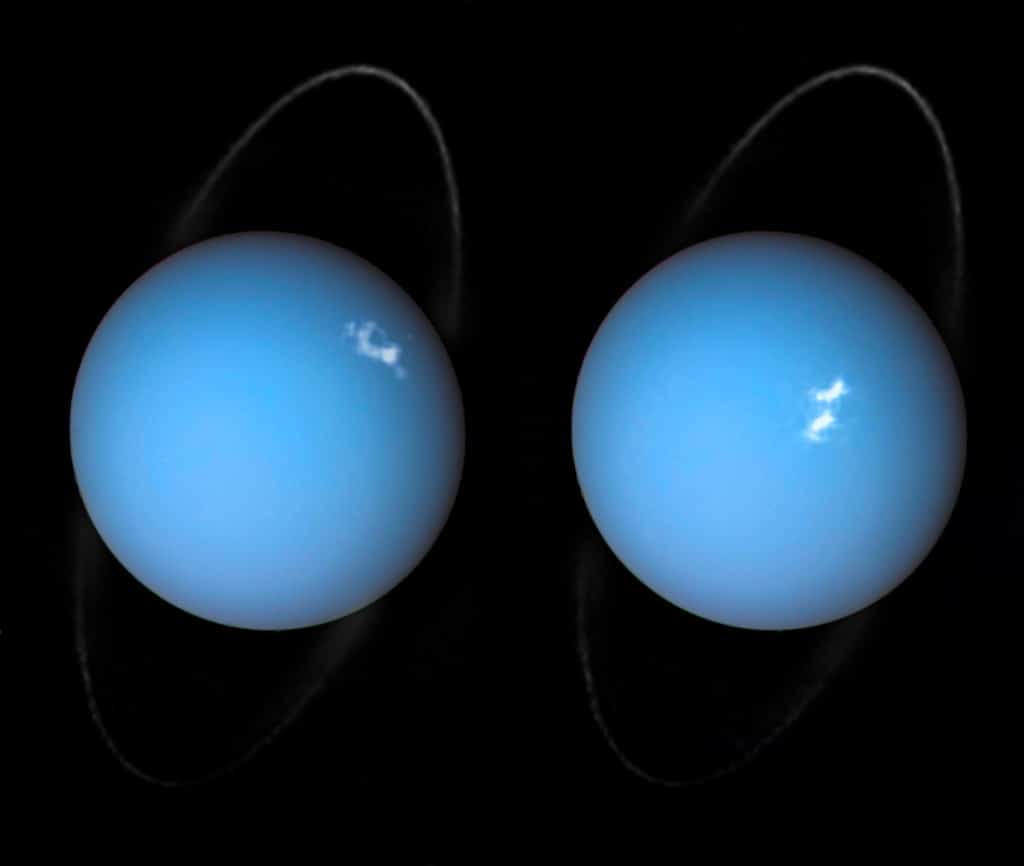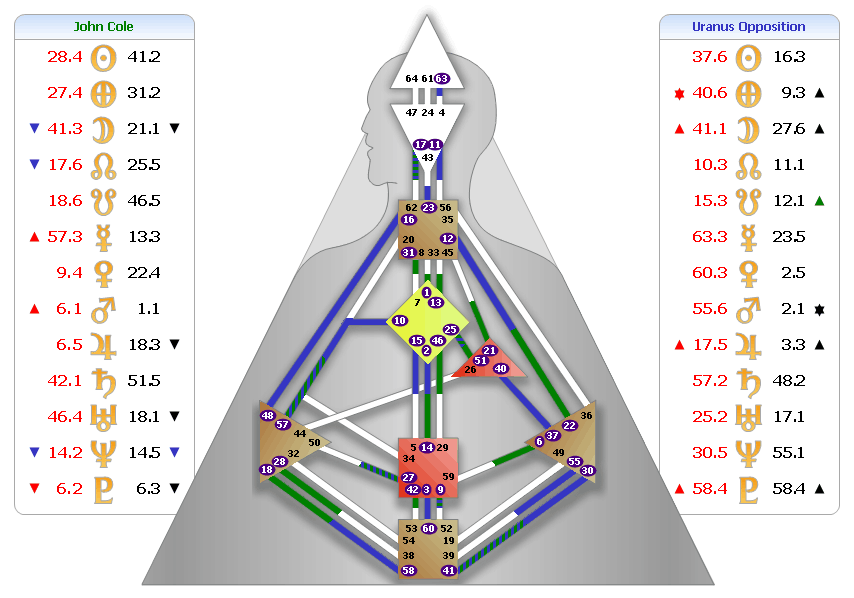The Uranus Opposition and The “Mid-Life Crisis”

We all meet this threshold in our early 40s, what popular culture calls the “mid-life crisis,” and what astrology and Human Design recognize as the Uranus Opposition. Astrologically, it’s the moment when Uranus reaches the point exactly opposite its position at birth, 180 degrees across the zodiac. This usually occurs around age 42, although the exact timing depends on Uranus’ speed at birth.
According to Human Design, a major shift occurred in 1781. Humans were no longer born with the traditional seven-centered chakra system but with a new nine-centered, Uranian form. These bodies are designed for a longer developmental process, with an expected lifespan of about 84 years, the length of one complete Uranus cycle through the zodiac and the mandala. The Uranus Opposition marks the midpoint of that cycle. It often arrives as a checkpoint or wake-up call, when we’re able to see our lives and ourselves from a different vantage point.
The opposition creates a time of tension between two positions: Uranus at birth, which carries the imprint of the past, and transiting Uranus around age 42, which brings pressure for change in the present. In astrology, Uranus represents individuality, disruption, and liberation, often showing up through sudden or unexpected events. In Human Design, it carries similar themes but is also linked to movement in the body and to the way the mind filters what is unusual or out of pattern.
The energy of this time can feel like electricity moving through the body. When it is met consciously, felt, expressed, or allowed to move, the Uranus Opposition can become an exciting period that opens new possibilities and a renewed sense of aliveness. When it is resisted or suppressed, that same force often shows up as shocks, accidents, or sudden disruptions from the outside.
When the energy is intense, it can feel like drastic changes are urgently needed. There is often some truth to that feeling, but the deeper purpose of this time is alignment with oneself and one’s path. It helps to view your life in its full context and to see the Uranus Opposition as an opportunity to make adjustments if you have been living in ways that are not true to who you are.
Human Design places the Uranus Opposition within a larger life story that unfolds through three major cycles: the Saturn Return, the Uranus Opposition, and the Chiron Return. The first cycle lasts from birth to the Saturn Return around age 28 or 29. This is the transition into adulthood, when a person begins to take responsibility for living as themselves and expressing their purpose. The Saturn Return is important for everyone, but it carries particular weight for those with strong sixth-line themes. For sixth-line Profiles, this is the time of going “onto the roof,” when life becomes more observational and inwardly focused, and authority begins to come from within rather than through trial and error.
For people without strong sixth-line themes, the Uranus Opposition is often one of the most significant transitions in life. Those with sixth-line Profiles still experience it, but compared to their Saturn and Chiron Returns, it may feel less defining. In any case, the Uranus Opposition marks the midpoint of an 84-year Uranian life cycle.
This period is also associated with a shift from the South Node to the North Node in terms of perspective and environment. The Nodes are not physical bodies but points where the Moon’s orbit crosses the path of the Sun and planets. They symbolize the path of our life. The South Node relates to the past, to what is familiar, comfortable, and often overdeveloped from experience. The North Node points toward the future and toward qualities and environments that require growth. It can feel risky or unfamiliar, but it draws us toward what is needed for further development.
It can be useful to view life as unfolding in two nodal phases, but the deeper point is integration. The South and North Node themes are meant to be woven into a single life, not lived as separate stories. In Human Design, this supports the unfolding of the life purpose shown in the Incarnation Cross. Whether or not you have strong sixth-line themes, this purpose begins to mature more fully about seven years later at the Chiron Return, around age 49 or 50. Chiron completes its full orbit at this time, returning to its birth position in the zodiac or mandala.
The Chiron Return marks the end of a major life cycle. It brings together the past and the future into the present and offers a chance to integrate what has been learned. Chiron’s position in the solar system reflects this role. It orbits between Saturn, which represents structure and tradition, and Uranus, which symbolizes innovation and freedom. It serves as a bridge between the old and the new. In Human Design, the Chiron Return is seen as the time when we may begin to fully express our purpose for being here.
Returning to Uranus, the opposition can be understood as a midpoint checkpoint in life. It is a moment when we can wake up to ourselves, see what supports our individuality and freedom, and recognize what restricts or limits it.
Popular culture often reduces this time to clichés, such as buying sports cars or making dramatic lifestyle changes. There are also quieter versions, like losing oneself in work, parenting, or responsibilities. These are broad generalizations, but they point to a deeper truth. At midlife, many people sense that there is more life to live and begin to make significant changes. How this shows up depends a great deal on the placement and nature of Uranus in the birth chart or BodyGraph.
In my own life, the Uranus Opposition arrived after I had spent about eight years working for a software company. I was physically and mentally burnt out from trying to live and work like a Generator. Strange health issues were surfacing, and I could no longer ignore them. I knew something had to change. After some reflection, I asked management for a 20 percent pay cut and a corresponding reduction in hours. It seemed like a way to keep meeting my responsibilities while giving my body the time it needed to recover.
Their answer was simple: no. They said they needed someone who could commit to the company. I remember laughing when I heard that and asking my manager, “So eight years here doesn’t count as commitment?” I left soon after and took a job with a friend at a software start-up. It felt like a step forward in some ways, but it was also like stepping from the pan into the fire. My workweek jumped from about 40 hours to 50 or 60. After four months, I realized that if I was going to work that hard, it should be for myself. I resigned and began working independently as a web developer.
Working for myself was a better fit, but I was still operating like a Generator and heading toward another collapse. Less than a year later, I hit a wall. I burned out so completely that I could barely function. I was exhausted, misaligned, and could only work a few hours a day to keep money coming in.
The good news was that I was finally free from corporate life, and I could see a path forward if I could restore my energy and health. It took months and then years of research, medical tests, and working with different specialists before I began to recover. All of this happened before I knew about Human Design. I kept searching for a root cause for what I was experiencing. When I eventually discovered Human Design and learned what it meant to be a Projector, I could finally see how compromising my work life had been, even though it felt necessary at the time to support my family.
I share this as one personal example, but the Uranus Opposition shows up differently for each person. It depends on how Uranus is configured in the birth chart and BodyGraph. Without going into everything that would be part of a full Uranus Opposition reading, many of the themes I described were clearly present in my own chart.

Looking at the chart for my Uranus Opposition, the Personality Sun is in the third line of Gate 16, which is associated with enthusiasm and the development of skills. Together, the positions of the Personality and Design Sun and Earth form the “Right Angle Cross of Planning 2”. This cross is about supporting the tribe and improving the collective through practical skills. It emphasizes developing abilities, making agreements, and securing resources in the service of something larger.
This phase was clearly important in my development. I left full-time corporate work and began building new skills, first in web development and later in Human Design. These skills gave me new ways to express myself while still providing for my family. With a 3/6 Profile in the Opposition chart, it was a transitional time marked by trial and error and a sense of being somewhat removed from my previous way of working in the world.
Looking at the nodal shift in my birth chart, I moved from a South Node environment and perspective to a North Node one. My Design South Node is at Gate 18.6, which points to a corrective environment concerned with collective survival. The Design North Node is at Gate 17.6, focused on conceptual awareness and the patterns that shape the future. Both have a sixth-line quality of transition and detachment. The main movement is from a Splenic focus on using physical energy for survival to the conceptual awareness of the Ajna. I had already been interested in astrology earlier in life, but in my early forties, I began studying it more seriously with others. Around that same time, I met the astrologer who introduced me to Human Design, setting off a sequence of events that deepened my understanding of myself and my purpose.
On the Personality side, the South Node is in Gate 46.5 and the North Node is in Gate 25.5. These gates describe what we are meant to notice in our environment. Both are located in the G Center in the BodyGraph, which is one of my two defined centers. This points to a consistent focus on identity, direction, and self throughout the nodal shift. Gate 46 in the I Ching is called Pushing Upward and is associated with determination and being in the right place at the right time. I experienced that often in my earlier professional life, although much of it happened while I was still trying to operate as a Generator, which came at a cost to my well-being and individuality.
At midlife, the nodal focus shifts to the North Node in Gate 25.5, an individual gate associated with innocence and universal love. It marks a change in how I see my environment and introduces the theme of “Recuperation: when innocence is sapped of its vitality, healing is the first priority”. As I mentioned earlier, after leaving those companies, I began working independently as a web developer. It was an empowering step, but healing from years of misalignment and exhaustion soon became central. My attention also turned toward understanding and inner alignment through a series of initiatory experiences.
There is much more that could be explored here, but the essential point is that these transitions are often visible in the major cycle charts, including the Uranus Opposition. Within the larger life story, this opposition is one of the key checkpoints on the path to living out one’s purpose. It functions as a wake-up call and an invitation to reassess how you are living and where you are headed. For many people, it feels like a fresh start or a major shift in orientation.
For some people, this can be a time of upheaval and significant change. Without context or understanding, it may bring anxiety, confusion, or a sense that life is no longer on solid ground. In the years leading up to the Uranus Opposition, it is common to feel restless, to question whether life could be different, and to sense a growing need to break free from something that limits your full expression.
The Uranus Opposition is not here to break us but to awaken us. It does not call for reckless change for its own sake. It invites honesty, helping us see what still has life in it and what has grown stale. For some, that may mean leaving a relationship, a career, or an identity. For others, it is a quieter and more internal reorientation.
Seen within the broader cycles of life, Saturn is responsibility, Uranus is individuation, and Chiron is healing and integration. This midpoint signals the beginning of a different kind of adulthood. Not one built on proving ourselves, but on remembering who we are and choosing to live from that place.
If we meet this time with curiosity rather than fear, it shifts from a crisis to a return. A return to the part of us that has always sensed there is more life to be lived, and that it is not too late to live it.

